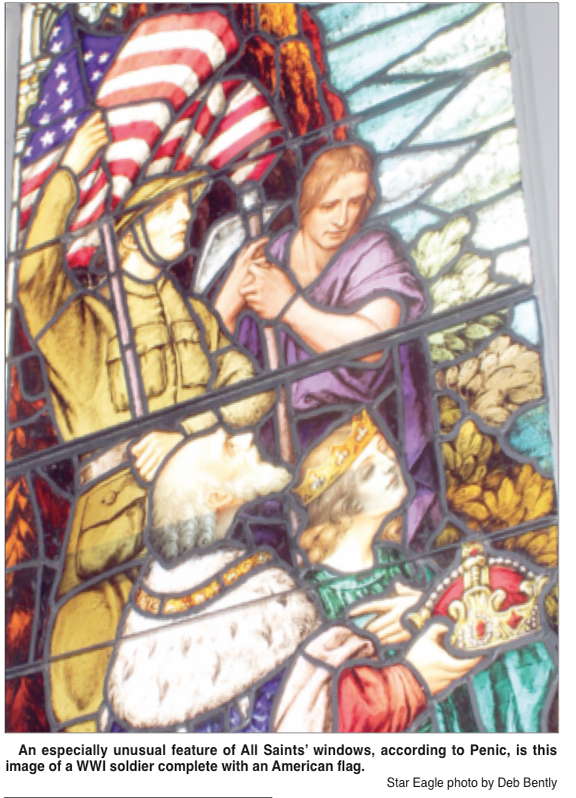By DEB BENTLY
Staff Writer
“These windows are 100 years old,” observes Caleb Penic of Winona’s Cathedral Crafts. “We want to help them last a millenia.”
Penic and coworker Jason Peterson were in New Richland last week to “storm proof” the large stained glass windows at the north and south ends of All Saints Catholic Church. The work entailed refinishing–even to some degree refurbishing–the wooden framing around the windows.
Made of cedar, the frames were beginning to weaken in places. Penic describes finding a small 12-inch tree growing from the wood easily 30 feet above the ground.
Sections of the frame were replaced and the whole frame was expanded and tightened by inserting bracing screws.
A protective coating was also put on the windows themselves. Then an outer covering of acrylic plexiglass was installed.
“Let’s face it,” comments Penic, “these large windows have to withstand a lot of weather that is tumultuous and turbulent. We want to make sure they’re protected.”
Penic had previously worked on the stained glass windows at All Saints in 2018, when the windows on the eastern and western sides of the church were removed and taken to Winona, where they were disassembled, refurbished, repaired, and reassembled. The larger windows on the north and south ends received the same attention in 2020.
One church member commented that the windows were far more beautiful and allowed in much more light after they were reinstalled.
Penic, who is Cathedral Crafts’ operations manager, admits he was “born into” the business of stained glass. The company was founded by his grandfather, LaVern Campbell, more than 50 years ago. His mother, Heidi, and father, Eric, are the current president and vice president.
His enthusiasm for the art form is irrepressible.
The windows were made by the Tyrolese Art Glass Company of Innsbruck, Austria, nearly 100 years ago. Penic comments that, although the company did not attain a reputation as strong as those of Zetter or Tiffany, its workmanship is comparable to the two more famous companies’. He says he feels privileged to work on these windows, commenting that they are now “priceless.”
“You would more commonly find windows of this quality in large cities in Europe,” he observes. He speculates that the order for the windows was likely placed during a World’s Fair or other large-scale international gathering. Given the much more primitive state of communication in the 1920s, it was one of few ways churches could get in touch with European craftsmen.
He speculates further about what it must have taken to transport the finished windows. “They were ‘horse-and-buggied’ to the nearest port in Europe, then put on a ship, then probably a train, and finally ‘horse-and-buggied’ to the church,” he says. “And yet they arrived whole and added so much beauty.”
One especially unusual feature which Penic notes regarding All Saints' large southern-facing window is that it includes a World War I soldier in an olive drab uniform holding an American flag. Penic comments on the gratitude many European communities felt for America’s intervention during the war and wonders whether that gratitude may have contributed to the impressive workmanship of the window.
